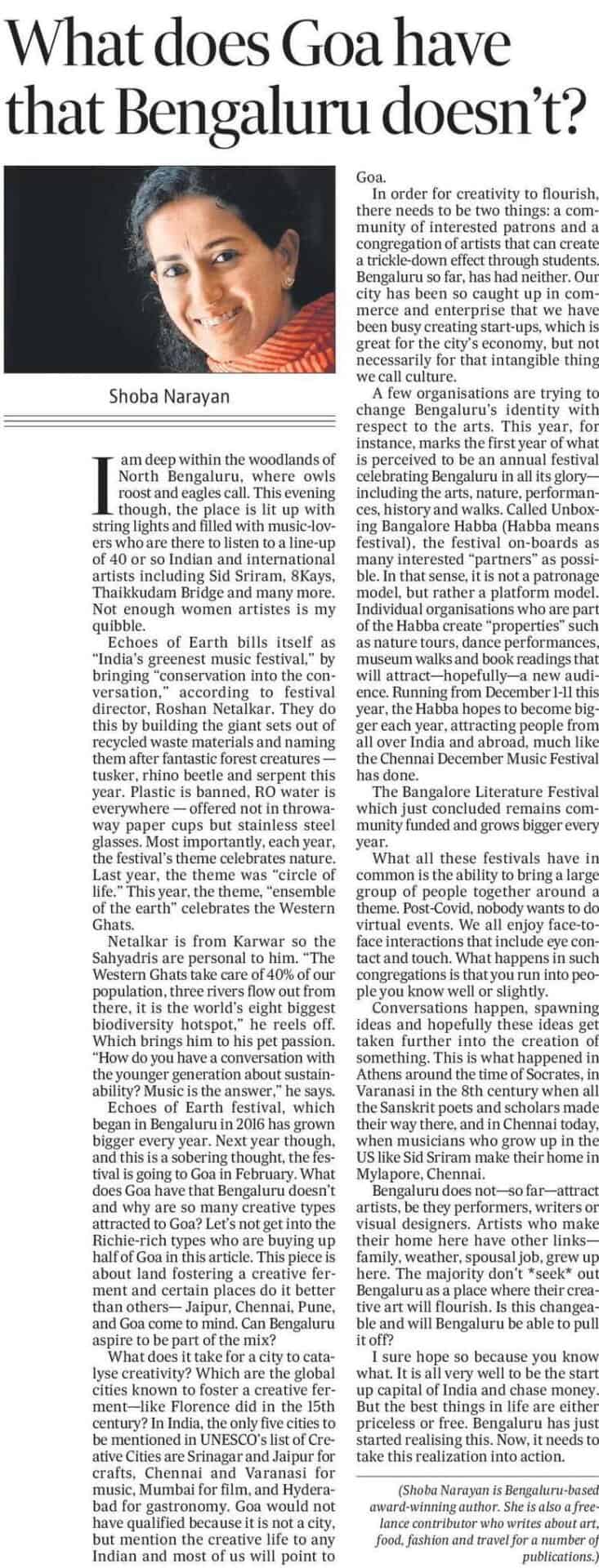I am deep within the woodlands of North Bangalore, where owls roost and eagles call. This evening though, the place is lit up with string lights and filled with music-lovers who are there to listen to a line-up of 40 or so Indian and international artists including Sid Sriram, 8Kays, Thaikkudam Bridge and many more. Not enough women artistes is my quibble.
Echoes of Earth bills itself as “India’s greenest music festival,” by bringing what festival “conservation into the conversation,” according to festival director, Roshan Netalkar. They do this by building the giant sets out of recycled waste materials and naming them after fantastic forest creatures– tusker, rhino beetle and serpent this year. Plastic is banned, RO water is everywhere—offered not in throwaway paper cups but stainless steel glasses. Most importantly, each year, the festival’s theme celebrates nature. Last year, the theme was “circle of life.” This year, the theme, “ensemble of the earth” celebrates the Western Ghats. Roshan is from Karwar so the Sahyadris are personal to him. “The Western Ghats take care of 40 percent of our population, three rivers flow out from there, it is the world’s 8th biggest biodiversity hotspot,” he reels off. Which brings him to his pet passion. “How do you have a conversation with the younger generation about sustainability? Music is the answer,” he says.
Echoes of Earth festival, which began in Bangalore in 2016 has grown bigger every year. Next year though, and this is a sobering thought, the festival is going to Goa in February. What does Goa have that Bangalore doesn’t and why are so many creative types attracted to Goa? Let’s not get into the Richie-rich types who are buying up half of Goa in this article. This piece is about land fostering a creative ferment and certain places do it better than others— Jaipur, Chennai, Pune, and Goa come to mind. Can Bangalore aspire to be part of the mix?
What does it take for a city to catalyze creativity? Which are the global cities known to foster a creative ferment—like Florence did in the 15th century? In India, the only five cities to be mentioned in UNESCO’s list of Creative Cities are Srinagar and Jaipur for crafts, Chennai and Varanasi for music, Mumbai for film, and Hyderabad for gastronomy. Goa would not have qualified because it is not a city, but mention the creative life to any Indian and most of us will point to Goa.
In order for creativity to flourish, there needs to be two things: a community of interested patrons and a congregation of artists that can create a trickle-down effect through students. Bangalore so far, has had neither. Our city has been so caught up in commerce and enterprise that we have been busy creating start-ups, which is great for the city’s economy, but not necessarily for that intangible thing we call culture.
A few organisations are trying to change Bangalore’s identity with respect to the arts. This year, for instance, marks the first year of what is perceived to be an annual festival celebrating Bangalore in all its glory—including the arts, nature, performances, history and walks. Called Unboxing Bangalore Habba (Habba means festival), the festival on-boards as many interested “partners” as possible. In that sense, it is not a patronage model, but rather a platform model. Individual organizations who are part of the Habba create “properties” such as nature tours, dance performances, museum walks and book readings that will attract—hopefully—a new audience. Running from December 1-11 this year, the Habba hopes to become bigger each year, attracting people from all over India and abroad, much like the Chennai December Music Festival has done.
The Bangalore Literature Festival which just concluded remains community funded and grows bigger every year.
What all these festivals have in common is the ability to bring a large group of people together around a theme. Post-Covid, nobody wants to do virtual events. We all enjoy face-to-face interactions that include eye contact and touch. What happens in such congregations is that you run into people you know well or slightly. Conversations happen, spawning ideas and hopefully these ideas get taken further into the creation of something. This is what happened in Athens around the time of Socrates, in Varanasi in the 8th century when all the Sanskrit poets and scholars made their way there, and in Chennai today, when musicians who grow up in the US like Sid Sriram make their home in Mylapore, Chennai.
Bangalore does not—so far—attract artists, be they performers, writers or visual designers. Artists who make their home here have other links—family, weather, spousal job, grew up here. The majority don’t *seek* out Bangalore as a place where their creative art will flourish. Is this changeable and will Bangalore be able to pull it off?
I sure hope so because you know what. It is all very well to be the start-up capital of India and chase money. But the best things in life are either priceless or free. Bangalore has just started realising this. Now, it needs to take this realization into action.
Shoba Narayan is Bangalore-based award-winning author. She is also a freelance contributor who writes about art, food, fashion and travel for a number of publications.



-k4lD-U204025897261YmH-250x250%40HT-Web.jpg)




Leave A Comment